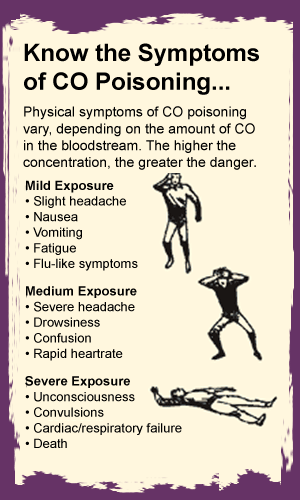Using Gas Safely Natural Gas Safety-SMART! Home
Carbon Monoxide Alert
You've probably heard of carbon dioxide (CO2)—our lungs produce it when we breathe, and trees and plants use it to make oxygen. Carbon monoxide (CO) sounds the same, but it is very different.
 Where Does CO Come From?
Where Does CO Come From?
CO is a dangerous gas that you can't smell or see. It is produced when people use natural gas or other fuels (such as gasoline, propane, fuel oil, and wood) without enough oxygen. Common sources of CO include gasoline engines running in closed garages, fuel-burning space heaters or water heaters with improper venting, and blocked chimneys or vent pipes.
What Are the Symptoms of CO Poisoning?
If you breathe in CO, it enters your bloodstream and robs oxygen from blood cells. This is called CO poisoning. The early effects of CO poisoning make you feel like you have the flu, but without the fever. Severe cases of CO poisoning can be deadly.
If you or someone in your home has these symptoms, get out of the house right away. Call 911, your local fire department, or local emergency medical service from a nearby phone.
How Can You Prevent CO Poisoning?
Tell the adults in your household they can prevent CO poisoning by paying attention to these four safety tips:
- Routinely maintain and inspect all heating systems and any fuel-burning appliances annually.
- Periodically check vents, flue pipes, and chimneys for corrosion or blockages.
- Never run your vehicle or fuel-burning equipment in an enclosed space.
- Buy, install, and use a CO alarm according to the manufacturer's instructions. (CO alarms are similar to smoke detectors.)



